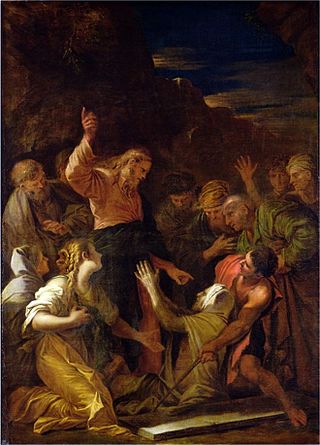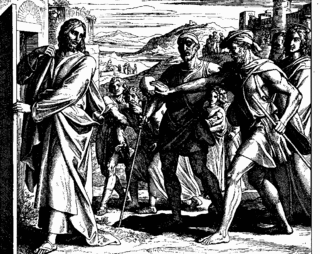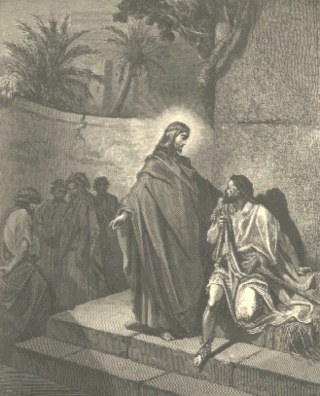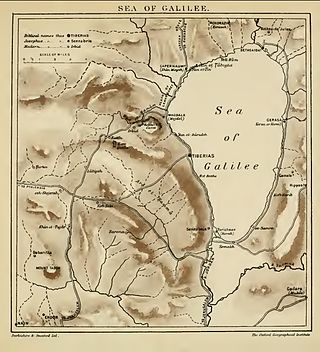
Luke 14 is the fourteenth chapter of the Gospel of Luke in the New Testament of the Christian Bible. It records one miracle performed by Jesus Christ on a Sabbath day, followed by His teachings and parables. The book containing this chapter is anonymous, but early Christian tradition uniformly affirmed that Luke the Evangelist composed this Gospel as well as the Acts of the Apostles.
Matthew 9:11 is a verse in the ninth chapter of the Gospel of Matthew in the New Testament.
Matthew 12:9 is the ninth verse in the twelfth chapter of the Gospel of Matthew in the New Testament.

Matthew 12:10 is the tenth verse in the twelfth chapter of the Gospel of Matthew in the New Testament.

Matthew 12:11 is the eleventh verse in the twelfth chapter of the Gospel of Matthew in the New Testament.

Matthew 12:13 is the thirteenth verse in the twelfth chapter of the Gospel of Matthew in the New Testament.
Matthew 12:22 is the 22nd verse in the twelfth chapter of the Gospel of Matthew in the New Testament.

Jesus heals a man with a withered hand on the Sabbath in one of his miracles recounted in the Gospels, namely in Matthew 12:9-13, Mark 3:1-6, and Luke 6:6-11.

Jesus cleansing a leper is one of the miracles of Jesus. The story is found in all three of the Synoptic Gospels: Matthew 8:1–4, Mark 1:40–45 and Luke 5:12–16.

The exorcism of a boy possessed by a demon, or a boy with a mute spirit, is one of the miracles attributed to Jesus reported in the synoptic Gospels, involving the healing of a demonically possessed boy through exorcism. The account appears first in the Mark 9:17-29 and is repeated, slightly amended, in Matthew 17:14-21 and Luke 9:40-44. In the Gospel narratives, this healing takes place following the Transfiguration.

Jesus' cleansing of ten lepers is one of the miracles of Jesus reported in the Gospels.

Healing the paralytic at Capernaum is one of the miracles of Jesus in the synoptic Gospels. Jesus was living in Capernaum and teaching the people there, and on one occasion the people gathered in such large numbers that there was no room left inside the house where he was teaching, not even outside the door. Some men came carrying a paralyzed man but could not get inside, so they made an opening in the roof above Jesus and then lowered the man down. When Jesus saw how faithful they had been, he said to the paralyzed man, "Son, your sins are forgiven."

The miracle of healing the man born blind is one of the miracles of Jesus in the Gospels, in which Jesus restored the sight of a man at Siloam. Although not named in the gospel, church tradition has ascribed the name Celidonius to the man who was healed. The account is recorded in the ninth chapter of the Gospel of John.

Jesus healing the bleeding woman is one of the miracles of Jesus recorded in the synoptic gospels.

Jesus healing an infirm woman is one of the miracles of Jesus in the Gospels.

Jesus healing two blind men is a miracle attributed to Jesus in the Gospel of Matthew. It follows immediately on the account of the Daughter of Jairus.

Jesus exorcising a mute is the last of a series of miracles of Jesus recorded in chapter 9 of the Gospel of Matthew. It appears in Matthew 9:32–34, immediately following the account of Christ healing two blind men.

The Calling of Matthew is an episode in the life of Jesus which appears in all three synoptic gospels, Matthew 9:9–13, Mark 2:13–17 and Luke 5:27–28, and relates the initial encounter between Jesus and Matthew, the tax collector who became a disciple.

Matthew's gospel and Luke's gospel record Jesus' message of woe to the unrepentant cities of Chorazin, Bethsaida and Capernaum, located around the northern shore of the Sea of Galilee, for their refusal to repent.
Matthew 12:14-16 is a set of verses in the twelfth chapter of the Gospel of Matthew in the New Testament.
















